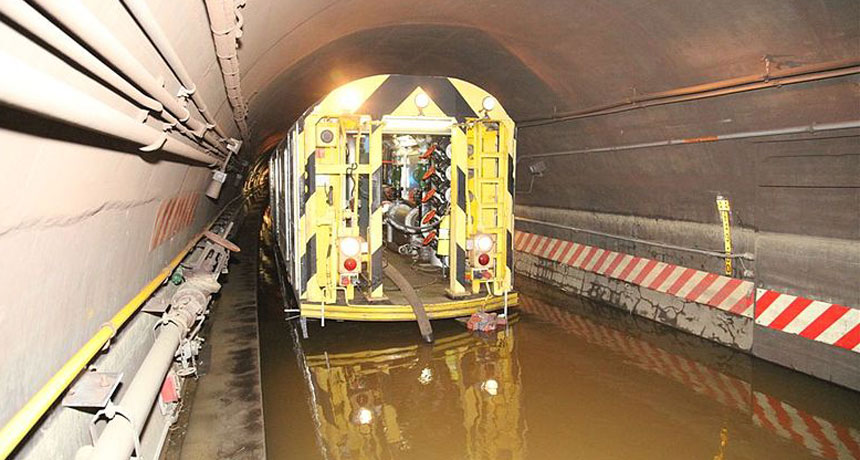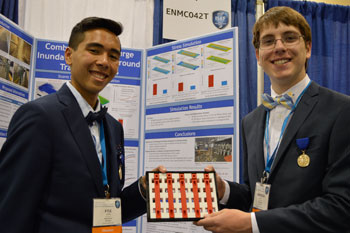Teens invent way to keep floodwaters out of subways
Rising sea levels would make such a device useful worldwide

In October 2012, Superstorm Sandy flooded many parts of the New York City subway system. Now, two teens who live in that area have invented a way for subway systems to keep out rising floodwaters.
Wikipedia Commons / vcohen
By Sid Perkins
PHOENIX, Ariz. —Superstorm Sandy slammed into the Eastern United States 3.5 years ago. It pummeled New York City with hurricane-force winds. In some places, the gales drove rising tides much farther onshore than normal. That wind-driven water, or storm surge, caused a lot of flooding, especially in the region’s subway system. Now, two teens have invented a device that could help prevent future subway floods.

Much of the floodwater entered the subway system through its ventilation grates, the teens say. Those metal grills usually lie at ground level. When the system is shut down ahead of a flood, engineers try to cover those grates with plywood and sandbags. But storm surges often wash away those measures. That allows water to flow into the tunnels. Raising those grates even a tiny bit above ground level would cost a lot of money. Other ideas have included building tall chimneys around the holes. That too would raise the grates — and cost a lot of money.
Kyle and Raymond came up with a different, less expensive idea. They designed a metal grate with a built-in, adjustable cover. When trains are running, one portion of the grate slides open to bring in fresh air. But when the system is shut down (and no ventilation is needed), that portion can be slid shut to completely block the grate. The teens showed off their design here, last week, at the Intel International Science and Engineering Fair. Created by Society for Science & the Public and sponsored by Intel, this year’s competition brought together more than 1,750 students from 75 countries. (SSP also publishes Science News for Students.)
Kyle and Raymond used a three-dimensional printer to make scale models of their adjustable grate. Their tests suggest the design won’t block too much of the airflow when the grate is open. But when closed, this grate would block almost all floodwater from seeping through to the tunnels below.
Their grate is the same size as the grates used now. So, it would be simple, they say, to lift out the old grate and drop in a replacement. Their design includes tamperproof features. They make sure that people don’t intentionally shut off airflow during normal conditions. For people with the proper key, it would only take a minute or two to close the grate ahead of a flood.
New York City’s subway system has more than 39,000 subway grates. About 1,000 are in very low-lying areas, Kyle and Raymond note. So a quick replacement of those shouldn’t be overly expensive. The damage prevented by blocking floodwaters should more than pay for the replacement grates, the teens suggest. Later, grates at elevations that are higher above sea level could be replaced as needed or desired.
Another advantage of their design: It can be adapted to fit any size grate. So, it should be easy to make replacement grates for subway systems elsewhere around the world. Many coastal cities — including Hong Kong, Shanghai and Guangzhou in China, to name just a few — have subway systems. And as sea levels steadily rise due to climate change, it’s just a matter of time before their subway tunnels are at risk of flooding during normal conditions, never mind a superstorm like Sandy.
Power Words
(for more about Power Words, click here)
climate change Long-term, significant change in the climate of Earth. It can happen naturally or in response to human activities, including the burning of fossil fuels and clearing of forests.
sea level The overall level of the ocean over the entire globe when all tides and other short-term changes are averaged out.
Society for Science and the Public, or SSP A nonprofit organization crated in 1921 and based in Washington, D.C. Since its founding, SSP has been not only promoting public engagement in scientific research but also the public understanding of science. It created and continues to run three renowned science competitions: the Science Talent Search (begun in 1942), the Intel International Science and Engineering Fair (launched in 1950) and Broadcom MASTERS (created in 2010). SSP also publishes award-winning journalism: in Science News (launched in 1922) and Science News for Students (created in 2003). Those magazines also host a series of blogs (including Eureka! Lab).
storm surge A storm-generated rise in water above normal tidal level. In most cases, the largest cause of storm surge is strong onshore winds in a hurricane or tropical storm.







